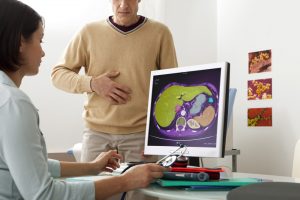Written by Taylor Woosley, Staff Writer. Findings from the NHANES 2003-2018 cycles show that subjects consuming 22.2 mg/day or greater of niacin had a significantly lower risk of NAFLD compared to participants with a niacin intake less than 16.4 mg/day.
 Over the past few decades, nonalcoholic fatty liver disease (NAFLD) has grown from a relatively unknown disease to the most common cause of chronic liver disease in the world, with over 25% of the world population currently thought to have NAFLD1. It is becoming a major cause of liver disease-related morbidity (cirrhosis, end-stage liver disease, hepatocellular carcinoma), as well as mortality2. NAFLD is histologically characterized by macrovesicular steatosis and further categorized into nonalcoholic fatty liver (NAFL) and nonalcoholic steatohepatitis (NASH)3.
Over the past few decades, nonalcoholic fatty liver disease (NAFLD) has grown from a relatively unknown disease to the most common cause of chronic liver disease in the world, with over 25% of the world population currently thought to have NAFLD1. It is becoming a major cause of liver disease-related morbidity (cirrhosis, end-stage liver disease, hepatocellular carcinoma), as well as mortality2. NAFLD is histologically characterized by macrovesicular steatosis and further categorized into nonalcoholic fatty liver (NAFL) and nonalcoholic steatohepatitis (NASH)3.
Nonpharmacological intervention, such as diet, weight reduction, and physical exercise, are key factors that affect the progression and development of NAFLD4. Niacin, also known as vitamin B3, serves as a nutritional precursor for both nicotinamide adenine dinucleotide (NAD) and nicotinamide adenine dinucleotide phosphate (NADP), which play crucial roles in cell metabolic reactions, energy metabolism, and redox reactions5. It’s mechanism of action is by oxidative stress reduction and inhibition of diacylglycerol acyltransferase 2 and other possible targets6.
Pan et al. conducted a cross-sectional study using data from the National Health and Nutrition Examination Survey (NHANES) from 2003-2018 to assess the relationship between dietary niacin intake and Nonalcoholic fatty liver disease (NAFLD). Dietary niacin intake was analyzed using two 24-hour dietary recall interviews which reported the types and quantities of food consumed. The USDA’s Food and Nutrient Database for Dietary Studies (FNDDS) was used to calculate nutrients in all food items. The definition of NAFLD was based on the United States fatty liver index (US-FLI), with NAFLD being determined with a score of US-FLI ≥ 30.
Covariates included age (classified into three groups: ≤39, 40-59, and ≥60 years), race/ethnicity, education levels, family income-poverty ratio, smoking status, physical activity levels, body mass index (BMI), and history of hypertension, diabetes, or high cholesterol. The Wilcoxon rank-sum test for continuous variables was utilized to compare differences between the two groups. The chi-squared test with the Rao-Scott second-order correction was used to compare differences between groups for categorical variables. Restricted cubic spline analysis was utilized to analyze the nonlinear associations between dietary niacin intake and NAFLD.
4378 subjects with NAFLD and 8877 non-NAFLD participants were included in the final analysis. After adjusting for covariates, the multivariable-adjusted ORs and 95% CIs for NAFLD were 0.84 (0.68-1.03), 0.80 (0.65-0.97), and 0.69 (0.55-0.85), respectively, when comparing the second, third, and fourth quartiles of niacin intake levels to the lowest quartile (ptrend = 0.001). Furthermore, a significant interaction between dietary niacin intake and hypertension with the presence of NAFLD was observed (pinteraction = 0.033).
Results of the study using data from NHANES 2003-2018 shows an inverse association between daily niacin intake and NAFLD. Additionally, a significant interaction between dietary niacin consumption and hypertension with the presence of NAFLD was noted. Study limitations include the observational nature of the study design, the inability to adjust for all potential confounders, and the potential for recall bias through the two 24-hour dietary recalls.
Source: Pan, Jie, Yuhua Hu, Nengzhi Pang, and Lili Yang. “Association between Dietary Niacin Intake and Nonalcoholic Fatty Liver Disease: NHANES 2003–2018.” Nutrients 15, no. 19 (2023): 4128.
© 2023 by the authors. Licensee MDPI, Basel, Switzerland. This article is an open access article distributed under the terms and conditions of the Creative Commons Attribution (CC BY) license (https://creativecommons.org/licenses/by/4.0/).
Click here to read the full text study.
Posted November 2, 2023.
Taylor Woosley studied biology at Purdue University before becoming a 2016 graduate of Columbia College Chicago with a major in Writing. She currently resides in Glen Ellyn, IL.
References:
- Younossi Z, Tacke F, Arrese M, et al. Global Perspectives on Nonalcoholic Fatty Liver Disease and Nonalcoholic Steatohepatitis. Hepatology. Jun 2019;69(6):2672-2682. doi:10.1002/hep.30251
- Castera L, Friedrich-Rust M, Loomba R. Noninvasive Assessment of Liver Disease in Patients With Nonalcoholic Fatty Liver Disease. Gastroenterology. Apr 2019;156(5):1264-1281.e4. doi:10.1053/j.gastro.2018.12.036
- Tokushige K, Ikejima K, Ono M, et al. Evidence-based clinical practice guidelines for nonalcoholic fatty liver disease/nonalcoholic steatohepatitis 2020. J Gastroenterol. Nov 2021;56(11):951-963. doi:10.1007/s00535-021-01796-x
- Kim MJ, Lee KJ. Analysis of the dietary factors associated with suspected pediatric nonalcoholic fatty liver disease and potential liver fibrosis: Korean National Health and Nutrition Examination Survey 2014-2017. BMC pediatrics. Mar 14 2020;20(1):121. doi:10.1186/s12887-020-02022-y
- Pan J, Hu Y, Pang N, Yang L. Association between Dietary Niacin Intake and Nonalcoholic Fatty Liver Disease: NHANES 2003-2018. Nutrients. Sep 25 2023;15(19)doi:10.3390/nu15194128
- Kashyap ML, Ganji S, Nakra NK, Kamanna VS. Niacin for treatment of nonalcoholic fatty liver disease (NAFLD): novel use for an old drug? J Clin Lipidol. Nov-Dec 2019;13(6):873-879. doi:10.1016/j.jacl.2019.10.006
